RBT® Task List by (BACB) 2025 Explained: What Every Behavior Technician Needs to Learn
Working directly with clients under the direction of Board Certified Behavior Analyses (BCBAs) or Board Certified Assistant Behavior Analyses (BCaBAs), Registered Behavior Technicians (RBTs) are the frontline implementers of Applied Behavior Analysis (ABA) treatment. Anyone working for this certification or trying to enhance their professional practice in behavioral health services must first understand the RBT Task List. This thorough guide dissects the key elements of the RBT Task List to enable you to learn the necessary abilities for certification and successful practice.
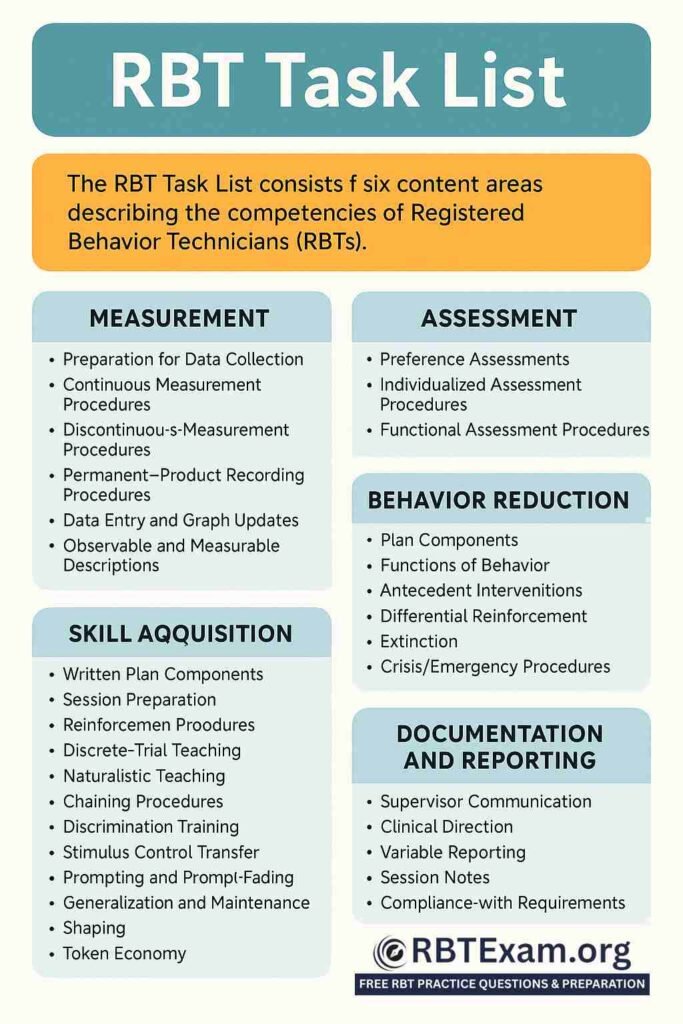
What is a Registered Behavior Technician (RBT®)?
A registered behavior technician is a paraprofessional certificated under Under careful supervision and direction of an RBT Supervisor and/or RBT Requirements Coordinator, they help to offer behavior-analytic services. Approved by the Behavior Analyst credential Board (BACB), this credential calls for proving expertise in a range of activities necessary to properly apply behavior analysis techniques with clients. Recognized worldwide, the RBT accreditation guarantees that practitioners have the fundamental knowledge required to provide competent behavioral treatments. Behavior Analyst Certification Board
👉Take a Free RBT® Practice Test Now
Understanding the RBT® Task List Framework
The basis for both the necessary 40-hour RBT training requirement and the RBT certification examination is the second edition RBT Task List. Published by the BACB, this paper lists the main responsibilities probably carried out by behavior technicians in different environments. Six key topic categories make up the Task List, covering the whole range of duties an RBT may come across in their professional life.
| Content Area | Focus |
|---|---|
| Measurement | Data collection and objective behavior documentation |
| Assessment | Conducting and assisting with various assessment procedures |
| Skill Acquisition | Implementing teaching procedures to develop new skills |
| Behavior Reduction | Implementing strategies to decrease challenging behaviors |
| Documentation and Reporting | Professional communication and record-keeping |
| Professional Conduct and Scope of Practice | Ethical guidelines and professional boundaries |
Although the Task List offers thorough direction, an RBT supervisor eventually decides which individual actions a behavior technician is qualified to do with specific clients. This guarantees suitable control and customizing of treatments tailored for clients.
A. Measurement: The Foundation of Effective Practice
A basic component of the evidence-based practice of ABA is the capacity for precise data collecting. To track client development objectively and guide treatment decisions, RBTs must be experts in several measuring techniques.

Key Measurement Tasks:
- Preparation for Data Collection (A-1)
- Organizing materials before sessions
- Understanding data sheets and collection protocols
- Calibrating timers or other measurement tools
- Continuous Measurement Procedures (A-2)
- Frequency recording: Counting how many times a behavior occurs
- Duration recording: Measuring how long a behavior lasts
- Latency recording: Measuring time between prompt and response
- Discontinuous Measurement Procedures (A-3)
- Partial interval recording: Noting if behavior occurs during any portion of interval
- Whole interval recording: Noting if behavior occurs throughout entire interval
- Momentary time sampling: Recording if behavior occurs at precise moment
- Permanent-Product Recording Procedures (A-4)
- Measuring outcomes or products left after behavior occurs
- Examples include completed worksheets, constructed items, or physical changes
- Data Entry and Graph Updates (A-5)
- Transferring raw data to electronic systems
- Creating and maintaining visual representations of data
- Ensuring accuracy in data transcription
- Observable and Measurable Descriptions (A-6)
- Using objective language to describe behaviors
- Avoiding subjective interpretations
- Specifying environmental conditions
Practice Tip: Always question yourself, while explaining: “Could another observer identify the exact same behavior based on my description?” If not, hone your operational definition to be more exact.
B. Assessment: Understanding Client Needs
By use of assessment processes, one may ascertain the present competencies, preferences, and behavior of a customer. Under supervision, RBTs help with several evaluation forms to compile vital data for treatment planning.

Assessment Competencies:
- Preference Assessments (B-1)
- Identifying preferred items or activities that may function as reinforcers
- Conducting formal preference assessments (e.g., paired-stimulus, multiple-stimulus)
- Documenting preference hierarchies
- Individualized Assessment Procedures (B-2)
- Supporting curriculum-based assessments
- Assisting with developmental assessments
- Helping evaluate social skills
- Functional Assessment Procedures (B-3)
- Assisting with functional behavior assessments
- Collecting ABC (Antecedent-Behavior-Consequence) data
- Supporting functional analysis procedures
| Assessment Type | Purpose | Example Procedures |
|---|---|---|
| Preference Assessment | Identify potential reinforcers | Paired-stimulus, multiple-stimulus |
| Curriculum-Based | Evaluate skill mastery | VB-MAPP, ABLLS-R, PEAK |
| Functional Assessment | Determine behavior function | ABC data collection, structured observations |
C. Skill Acquisition: Teaching New Behaviors
RBTs’ main duty is carrying out instructional programs to let customers acquire fresh talents. This calls on knowledge of several teaching strategies and reinforcement techniques.
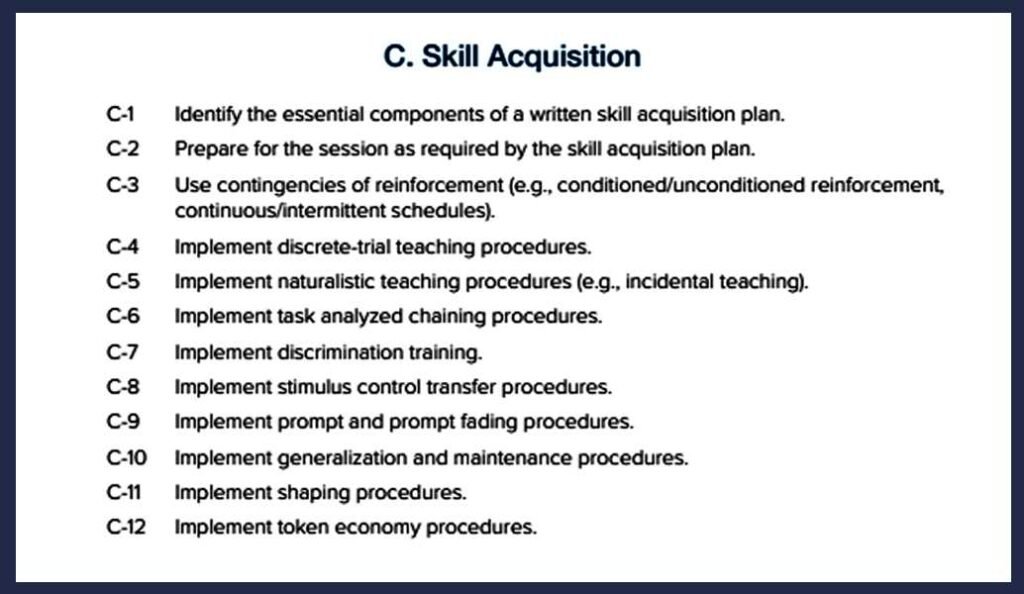
Essential Skill Acquisition Competencies:
- Written Plan Components (C-1)
- Identifying essential elements of skill acquisition plans
- Understanding operational definitions and success criteria
- Following procedural guidelines
- Session Preparation (C-2)
- Organizing materials and reinforcers
- Setting up the physical environment
- Reviewing protocols and data sheets
- Reinforcement Procedures (C-3)
- Using conditioned and unconditioned reinforcers
- Implementing continuous and intermittent schedules
- Pairing new reinforcers
- Discrete-Trial Teaching (C-4)
- Implementing structured teaching trials
- Managing intertrial intervals
- Providing appropriate antecedents and consequences
- Naturalistic Teaching (C-5)
- Using incidental teaching opportunities
- Following client motivation
- Embedding learning in natural routines
- Chaining Procedures (C-6)
- Forward chaining
- Backward chaining
- Total task presentation
- Discrimination Training (C-7)
- Teaching clients to respond differently to different stimuli
- Implementing errorless learning procedures
- Transferring stimulus control
- Stimulus Control Transfer (C-8)
- Shifting control from one stimulus to another
- Fading artificial cues
- Promoting natural environmental control
- Prompting and Prompt Fading (C-9)
- Using least-to-most or most-to-least prompting hierarchies
- Implementing time delay procedures
- Systematically fading prompts
- Generalization and Maintenance (C-10)
- Programming for skill transfer across settings
- Ensuring skills maintain over time
- Varying stimuli and instructors
- Shaping (C-11)
- Reinforcing successive approximations
- Gradually increasing response requirements
- Building complex behaviors from simpler ones
- Token Economy (C-12)
- Delivering tokens contingent on behavior
- Establishing exchange systems
- Managing token boards or economies
Implementation Insight: Studies published in the Journal of Applied Behavior Analysis repeatedly find that combining teaching strategies (discrete trial and naturalistic) results in superior skill learning and generalization than utilizing either approach alone. National Library of Medicine
D. Behavior Reduction: Addressing Challenging Behaviors
RBTs have to be proficient in carrying out behavior modification techniques created by their superiors to safely and successfully lower demanding behaviors.
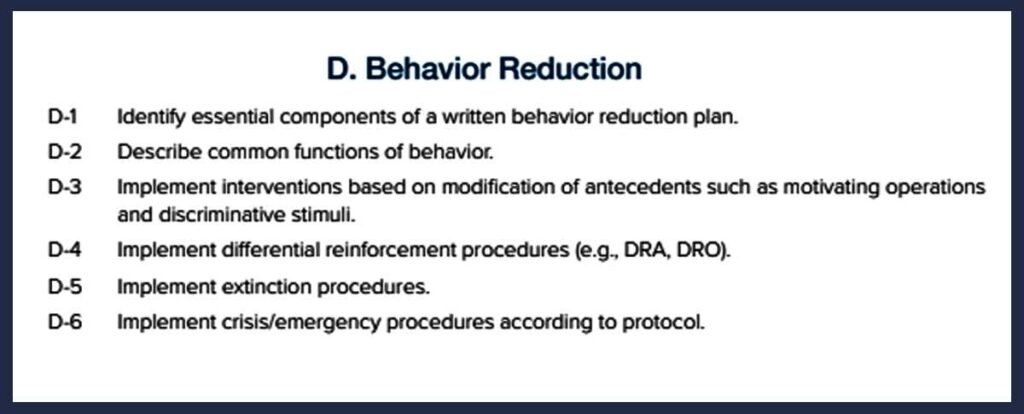
Key Behavior Reduction Competencies:
- Plan Components (D-1)
- Identifying essential elements of behavior reduction plans
- Understanding target behaviors and replacement behaviors
- Following safety protocols
- Functions of Behavior (D-2)
- Understanding the four primary functions:
- Access to attention
- Access to tangibles/activities
- Escape/avoidance
- Sensory stimulation
- Recognizing how function informs intervention
- Understanding the four primary functions:
- Antecedent Interventions (D-3)
- Modifying motivating operations
- Managing discriminative stimuli
- Creating enabling environments
- Differential Reinforcement (D-4)
- DRA (Differential Reinforcement of Alternative behavior)
- DRO (Differential Reinforcement of Other behavior)
- DRI (Differential Reinforcement of Incompatible behavior)
- Extinction (D-5)
- Withholding reinforcement for previously reinforced behavior
- Managing extinction bursts
- Consistent implementation
- Crisis/Emergency Procedures (D-6)
- Following agency-approved crisis protocols
- Prioritizing client and staff safety
- Documenting emergency situations
| Function of Behavior | Common Examples | Potential Interventions |
|---|---|---|
| Attention | Crying, aggression, loud vocalizations | Noncontingent attention, DRA for appropriate requests |
| Tangible/Activity | Grabbing items, tantrums | Teaching appropriate requesting, token economies |
| Escape/Avoidance | Task refusal, eloping | Visual schedules, choice-making, breaking tasks down |
| Sensory | Self-stimulatory behavior, self-injury | Sensory alternatives, environmental modifications |
E. Documentation and Reporting: Professional Communication
Treatment integrity, service validation, team communication—all of which depend on accurate and clear documentation—dependent on RBTs have to keep exhaustive records according professional guidelines.
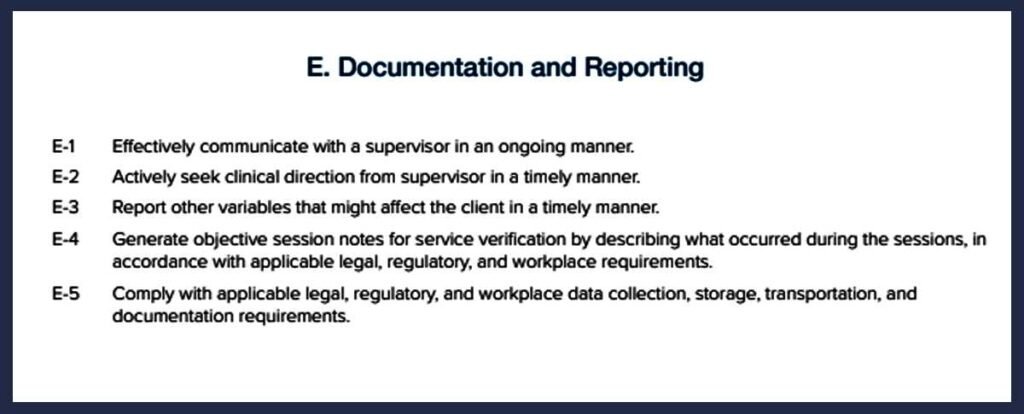
Documentation Requirements:
- Supervisor Communication (E-1)
- Maintaining ongoing dialogue with supervisors
- Reporting client progress regularly
- Discussing implementation challenges
- Clinical Direction (E-2)
- Actively seeking guidance when needed
- Requesting clarification of procedures
- Reporting unusual circumstances promptly
- Variable Reporting (E-3)
- Documenting factors that might affect client performance
- Noting medication changes, illness, or life events
- Reporting environmental changes
- Session Notes (E-4)
- Creating objective descriptions of session activities
- Documenting behaviors without interpretation
- Meeting legal and workplace requirements
- Compliance with Requirements (E-5)
- Following data security protocols
- Maintaining confidentiality
- Adhering to organizational policies
Documentation Best Practice: Use the SOAP format—Subjective, Objective, Assessment, Plan—when creating session notes to guarantee thorough documentation compliant with clinical and billing criteria.
F. Professional Conduct and Scope of Practice: Ethical Foundations
RBTs have to keep moral behavior always and be aware of their professional limits. This section addresses obligations and professional connections.
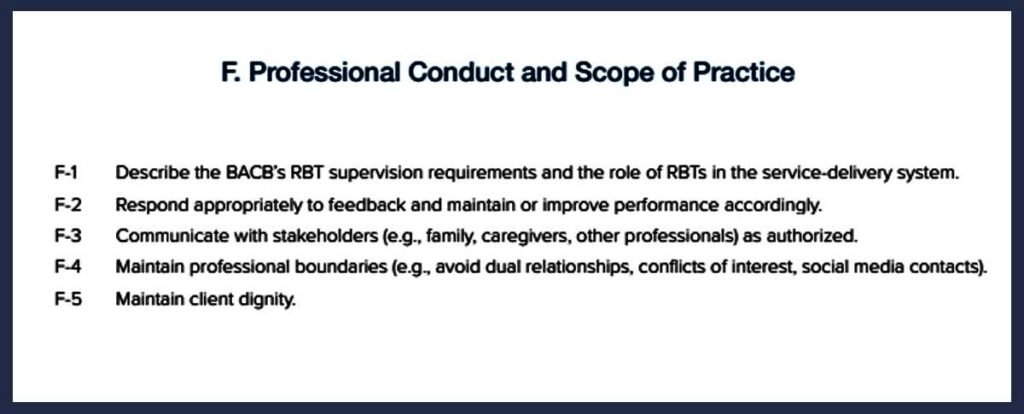
Professional Requirements:
- Supervision Requirements (F-1)
- Understanding BACB supervision standards
- Recognizing the RBT’s role in service delivery
- Following supervision protocols
- Feedback Response (F-2)
- Accepting constructive criticism
- Implementing suggested changes
- Demonstrating continuous improvement
- Stakeholder Communication (F-3)
- Interacting appropriately with families
- Communicating with other professionals
- Respecting authorization boundaries
- Professional Boundaries (F-4)
- Avoiding dual relationships
- Recognizing conflicts of interest
- Maintaining appropriate social media practices
- Client Dignity (F-5)
- Respecting privacy and confidentiality
- Using person-first language
- Promoting autonomy and self-determination
RBT Certification Process
Becoming an RBT involves several key steps established by the BACB:
- Eligibility Requirements
- Be at least 18 years of age
- Hold a minimum of a high school diploma or equivalent
- Pass a background check
- Complete a 40-hour training course
- Pass the RBT Competency Assessment
- 40-Hour Training
- Complete training based on the RBT Task List
- Training must be conducted by a qualified BACB certificant
- Cover all content areas in the Task List
- Initial Competency Assessment
- Demonstrate practical skills from the Task List
- Assessment conducted by a qualified BACB certificant
- Must be completed within 90 days of application
- RBT Examination
- Pass the RBT exam administered through Pearson VUE
- Multiple-choice format based on Task List content
- Minimum passing score determined by BACB
- Maintenance Requirements
- Receive ongoing supervision from a qualified supervisor
- Complete annual competency assessments
- Renew certification yearly
Certification Tip: For first-time test-takers who have followed a comprehensive training program, the RBT exam boasts a pass rate of around 86%. Your chances of success are much raised by targeted study on the Task List topic areas. ABA Resource Center
The Importance of RBTs in Behavioral Health Services
The delivery of good behavioural services depends much on registered behaviour technicians. Their efforts immediately affect the results for clients and the standard of ABA treatment courses. Studies have pointed up some important effects:
- Direct Implementation
- RBTs typically provide the majority of direct service hours
- Their implementation fidelity affects treatment outcomes
- Consistent application of protocols ensures progress
- Data Collection
- RBTs generate the data that drives decision-making
- Accurate measurement is essential for program modification
- Progress monitoring depends on quality data collection
- Client Relationships
- RBTs often develop strong therapeutic relationships with clients
- These relationships can enhance motivation and cooperation
- Trust between clients and RBTs facilitates treatment success
- Team Integration
- RBTs bridge communication between clients and supervisors
- They provide valuable insights from direct observation
- Their feedback informs program adjustments
Studies have found that well-trained RBTs running highly consistent programs yield noticeably better client results than those with less training or poorer implementation consistency. This emphasises the need of knowing the Task List competencies completely.
Challenges and Considerations in RBT Practice
While the RBT certification provides a strong foundation, several challenges exist in real-world implementation:
Common Challenges:
- Burnout and Turnover
- High emotional demands can lead to burnout
- Competitive job market creates turnover challenges
- Strategies for self-care are essential for longevity
- Supervision Quality
- Supervision experiences vary widely
- Effective supervision is critical for skill development
- Communication barriers may impact implementation
- Scope of Practice Issues
- Maintaining appropriate professional boundaries
- Recognizing limitations of the RBT role
- Avoiding practicing beyond certification parameters
- Professional Development
- Limited advancement without additional credentials
- Need for ongoing training beyond minimum requirements
- Building specialized skills for specific populations
Addressing These Challenges:
- Organizational Support: Agencies that provide ongoing training, competitive compensation, and supportive environments tend to have lower turnover rates.
- Clear Communication Channels: Establishing structured supervision protocols and feedback mechanisms improves implementation quality.
- Continuing Education: Pursuing specialized training in areas of interest enhances professional satisfaction and client outcomes.
- Self-Care Strategies: Developing sustainable self-care practices prevents burnout and promotes career longevity.
Future Directions in RBT Practice
The field of behavior analysis continues to evolve, and RBT practices are likely to see several developments:
- Telehealth Integration
- Remote service delivery expanding access
- New competencies for virtual implementation
- Technology-enhanced data collection systems
- Specialization Opportunities
- Growing focus on population-specific training
- Expanded roles in schools and healthcare settings
- Advanced RBT credentials for experienced practitioners
- Evidence-Based Supervision
- Research on effective supervision models
- Structured approaches to RBT professional development
- Performance-based evaluation systems
- Interdisciplinary Collaboration
- Increased integration with related disciplines
- Expanded scope in multidisciplinary teams
- Enhanced communication across professions
Conclusion
The Task List for Registered Behavior Technician (RBT) offers a thorough structure for acquiring the required competencies to offer successful behavioral treatments. RBTs set themselves for professional success and, most crucially, good client outcomes by honing the abilities in all six topic areas.
Success as an RBT depends on:
- Thorough understanding of the Task List components
- Regular practice and refinement of implementation skills
- Ongoing supervision and professional development
- Commitment to ethical practice and client dignity
- Collaboration with supervisors and interdisciplinary teams
Whether your goal is first certification or improvement of your current practice, concentrated emphasis on the fundamental competencies described in this book will enable you to give the people you treat the best possible quality of care. The RBT certification is a dedication to evidence-based practice and ongoing field improvement in applied behaviour analysis as much as a professional certificate.
RBTs greatly help to improve behavioural health services and client well-being across all environments and groups by keeping high standards of practice consistent with the Task List.





